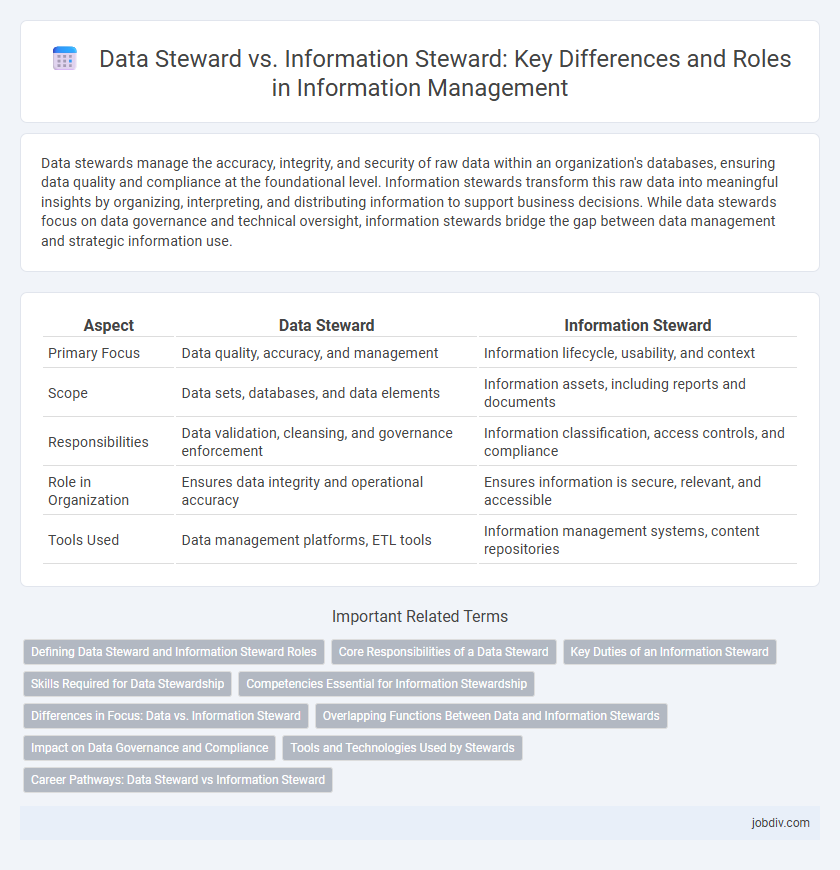Data stewards manage the accuracy, integrity, and security of raw data within an organization's databases, ensuring data quality and compliance at the foundational level. Information stewards transform this raw data into meaningful insights by organizing, interpreting, and distributing information to support business decisions. While data stewards focus on data governance and technical oversight, information stewards bridge the gap between data management and strategic information use.
Table of Comparison
| Aspect | Data Steward | Information Steward |
|---|---|---|
| Primary Focus | Data quality, accuracy, and management | Information lifecycle, usability, and context |
| Scope | Data sets, databases, and data elements | Information assets, including reports and documents |
| Responsibilities | Data validation, cleansing, and governance enforcement | Information classification, access controls, and compliance |
| Role in Organization | Ensures data integrity and operational accuracy | Ensures information is secure, relevant, and accessible |
| Tools Used | Data management platforms, ETL tools | Information management systems, content repositories |
Defining Data Steward and Information Steward Roles
Data Stewards are responsible for managing the quality, integrity, and security of data within specific datasets or systems, ensuring compliance with organizational policies and standards. Information Stewards oversee the broader lifecycle of information, aligning data governance with business objectives and facilitating effective information usage across departments. Both roles collaborate to maintain data accuracy and accessibility while supporting regulatory requirements and strategic decision-making.
Core Responsibilities of a Data Steward
A Data Steward is responsible for managing the quality, accuracy, and integrity of data within an organization, ensuring data compliance with regulatory standards and internal policies. They oversee data lifecycle management, including data collection, storage, and usage, to maintain reliable and accessible data assets. Their core responsibilities include defining data standards, monitoring data quality metrics, and facilitating collaboration between data owners and users to support data governance initiatives.
Key Duties of an Information Steward
An Information Steward is responsible for ensuring data quality, managing data access permissions, and maintaining compliance with regulatory standards across the organization. Key duties include monitoring metadata accuracy, coordinating with data stewards to enforce data governance policies, and facilitating data lifecycle management to support business intelligence initiatives. This role emphasizes transforming raw data into reliable, accessible information that drives strategic decision-making.
Skills Required for Data Stewardship
Data stewardship demands expertise in data governance, data quality management, and regulatory compliance to ensure accurate and secure data handling. Proficiency in metadata management, data lineage, and data lifecycle processes is essential for maintaining data integrity and facilitating accessibility. Strong communication skills and collaboration with cross-functional teams support effective data policy implementation and stakeholder engagement.
Competencies Essential for Information Stewardship
Data stewards primarily focus on data quality, accuracy, and compliance, ensuring that data is properly maintained and used according to organizational policies. Information stewards require competencies in information governance, privacy regulations, and cross-functional collaboration to manage the lifecycle of information assets effectively. Mastery in data classification, metadata management, and risk assessment is essential for information stewardship to support strategic decision-making and regulatory compliance.
Differences in Focus: Data vs. Information Steward
Data stewards concentrate on managing raw data quality, accuracy, and consistency within databases, ensuring data is properly maintained and accessible. Information stewards focus on transforming data into meaningful, actionable insights by overseeing the context, relevance, and usability of information across business processes. The primary difference lies in data stewards handling technical data management while information stewards manage the interpretation and application of that data for decision-making.
Overlapping Functions Between Data and Information Stewards
Data Stewards and Information Stewards both play crucial roles in managing organizational assets, focusing on the quality, integrity, and accessibility of data and information respectively. Overlapping functions include ensuring data accuracy, implementing governance policies, and facilitating collaboration between technical teams and business units. Both roles require a deep understanding of regulatory compliance, metadata management, and user training to uphold data and information standards across the enterprise.
Impact on Data Governance and Compliance
Data Stewards play a crucial role in ensuring data quality, accuracy, and consistency, directly impacting data governance by enforcing policies and standards throughout the data lifecycle. Information Stewards focus on managing data accessibility, security, and compliance with regulatory requirements, thereby strengthening organizational adherence to legal frameworks like GDPR and HIPAA. Together, their collaboration enhances overall data governance frameworks, ensuring both operational efficiency and regulatory compliance are maintained effectively.
Tools and Technologies Used by Stewards
Data Stewards primarily utilize data governance platforms, metadata management tools, and quality monitoring software to ensure data accuracy, consistency, and compliance throughout the organization. Information Stewards often rely on content management systems, knowledge management tools, and semantic technologies to organize, classify, and facilitate access to information assets. Both roles increasingly integrate AI-driven analytics and automation tools to enhance stewardship efficiency and data-informed decision-making.
Career Pathways: Data Steward vs Information Steward
Data Stewards typically focus on managing data quality, metadata, and enforcing data governance policies within IT and data management teams, developing expertise in data compliance and security. Information Stewards concentrate on overseeing overall information lifecycle, including content management, knowledge sharing, and aligning information strategy with business goals, often collaborating across departments such as records management and compliance. Career pathways for Data Stewards often lead to roles like Data Governance Manager or Data Quality Analyst, while Information Stewards may progress toward roles such as Information Governance Officer or Chief Information Officer.
Data Steward vs Information Steward Infographic

 jobdiv.com
jobdiv.com